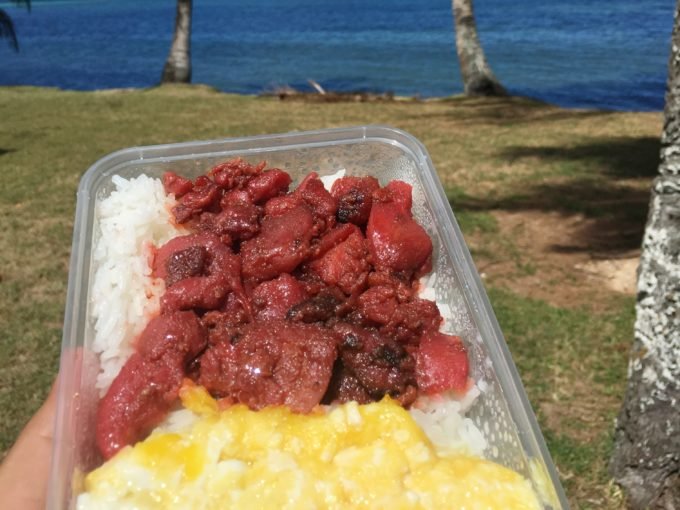
This Really Feels Like a “Wait 20 Minutes Before You Swim” Scenario

This Really Feels Like a “Wait 20 Minutes Before You Swim” Scenario
Chicken tocino in Guam
“So many different people live on Guam,” the driver explains as we travel along tree-shrouded roads with shadowy mountain outlines in the distance, after a middle-of-the-night arrival at Guam International Airport. He gives me the list: “Chamorro, Filipino, Korean, Japanese, American.” He sizes me up. “Are you a journalist?” When I tell him I’m Malaysian and that I’m writing about marine conservation, not Guam’s military significance amid US-North Korea tensions, he quickly says “Great!”
A few mornings later, I join a group of South Korean tourists to swim in the 3,000-year-old freshwater Marbo Cave, to be followed by snorkeling in Fish Eye Marine Park.
Our guide is Tropical Tours Guam’s Jose Castro. “We go ppalli ppalli!”—fast fast! A Guam native raised in Hawaii, Jose returned to Guam for the slower pace (despite his taste for ppalli ppalli driving). In 2015, Jose opened Tropical Tours Guam with a cousin and a childhood friend, to bring visitors to sites they frequented as children.
But the first order of business is breakfast. So, we load the van with delicacies purchased at a gas station. As we charge downhill through a jungle thicket, chicken tocino flies out of a container and splatters onto the car window. Jose doesn’t seem to mind. “Why do you think I have this belly?” he asks. “From eating chicken tocino.”
Traditionally a Pinoy comfort food, chicken tocino is a Guam breakfast staple, thanks to the island’s large Filipino population.
As I devour salty, blood-red chicken chunks, fried mushy eggs as yellow as the sun and rice as sweet as floral extract, I juggle the other two parts of my mobile buffet. Spam onigiri is a combination of good old-fashioned American canned spam, wrapped with seaweed on a sticky Japanese rice ball. The result is a burst of saltiness with a tinge of teriyaki.
Hotteok are doughy Korean pancakes stuffed with gooey brown sugar wrapped in thin greased-smudged paper, just like those sold by Seoul street vendors.
The odd mixture of food settling in my stomach reminds of Malaysia’s rojak. There are many variations of this tangy fruit and vegetable salad, some of which include cuttlefish and prawn fritters doused in spicy peanut sauce. Rojak, in colloquial Malay, also refers to the country’s ethnic mix. Guam has been a similar hodgepodge of experiences.
At Marbo Cave, after wolfing down the last of the hotteok, I hop around giant ferns and dangling tree roots towards the smell of damp earth and moss that beckons me for a swim. Jose tells me that he’s glad to meet a journalist who isn’t writing about North Korea’s nuclear threat. Looking at the vast stretch of orange earth and endless fern-covered cliffs framing the sparkling blue Pacific Ocean, politics are the last thing on my mind.